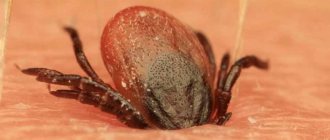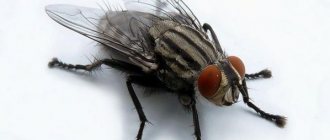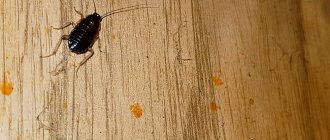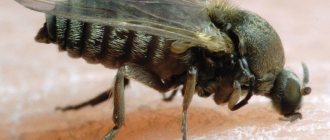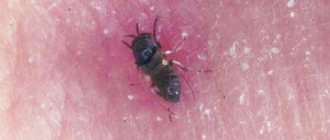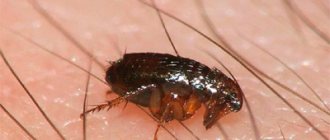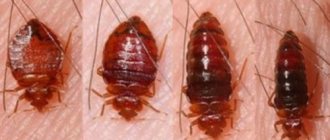What types of animal are there?
In total, there are more than 54,000 different species of ticks, which are grouped into 6 orders (Opilioacarida, Holothyrida, Ixodida, etc.). Thus, on the territory of the Russian Federation the following types of ticks are most often found:
- encephalitic;
- ixodid;
- argassy;
- gamas;
- subcutaneous;
- scabies;
- bed.
Attention . Judging from the point of view of danger, the entire set of tick species can be divided into two groups: those that do not pose a danger to people (for example, bed ticks) and individuals that pose a threat to human health, and sometimes life (encephalitis, ixodid ticks, etc. .).
Myths and misconceptions: is it an insect or not, when and for whom are they dangerous?
There are a variety of myths among people regarding ticks and their danger to humans. As an example, here are some of the most common misconceptions:
- Myth No. 1: Ticks are insects - this is a misconception. This parasite belongs to animals (subclass - arthropods, class - arachnids).
- Myth No. 2: Ticks are dangerous only from May to June - in fact, carriers of serious diseases from this category of arachnids pose a danger to human health, regardless of the time of year. Moreover, their peak activity occurs in May and September. This means that it is at this time that the risk of a bite increases.
- Myth No. 3: Ticks most often bite people wearing white clothes - the visual apparatus of these parasites is primitive, so they cannot distinguish colors. They grab onto everything that moves past them. The color of a person's clothing in this case does not matter.
- Myth No. 4: The tick bite area needs to be filled with oil, then it will come out on its own - such a measure will not be beneficial, moreover, its use can be dangerous for humans if the tick turns out to be a carrier of serious diseases.
- Myth No. 5: You can protect yourself from a tick bite by getting vaccinated - there is no single vaccine that protects against all diseases that can be transmitted by ticks. For example, there is a vaccination against encephalitis ticks, but it will not prevent the development of Lyme disease.
Types of ticks
For many, “ticks” are only those that live in the forest and bite animals and people. But in nature there are a huge number of ticks, divided into species and differing in diet and lifestyle. We will now look at some types of mites. The classification of mites distinguishes three independent orders.
- Grasshopper mites
is a species of arthropod that lives in the tropics and subtropics. The name comes from the structure of the hind legs, which, with their long and massive appearance, resemble haymakers. The tick itself reaches a size of up to 3 mm and is considered one of the largest among its fellows. His head is combined with his chest, forming a single part, separated from the belly. The diet of such mites includes fungal spores, pollen and other smaller insects. - Parasitiform mites
are the most dangerous species, including parasites of vertebrates, predators, and saprotrophs (organisms that serve to destroy the remains of living beings). It is these ticks that are carriers of diseases, in most cases leading to disability or death. - Acarimorphic mites
- this largest group includes about 15 thousand species, half of which parasitize vertebrate animals. This explains their diet - skin, hair, feathers. The size is extremely small, usually does not exceed 0.3 mm, however, not only the head, but also the abdomen is divided into segments. This group also includes disease carriers, but in smaller numbers.
In addition to the three main and collective groups into which scientists classify ticks, there are many other species. Let's look at the most common ones:
- Ixodid ticks
in most cases they are carriers of encephalitis. Particular activity occurs in May-July; insects live in grass or bushes and it is from the vegetation that they fall on humans. Moving from below, the tick looks for a suitable place with thin skin, most often the wrists, neck, and head. - Argasid mites
They differ from other species in that they hunt all year round. They live in dark and hard-to-reach places, such as nests, caves and various cracks. If there is a lack of blood intake, argasid mites hibernate. However, it only takes them half an hour to be completely saturated with blood, and only a minute to infect a victim with a serious disease. - Subcutaneous mites
live under human skin, as their name suggests. They develop and live under the skin for quite a long time until they are hatched, feeding on dead cells. Acne, itching and severe redness occur at the affected areas. Infection occurs from carriers of the disease through towels, touches and personal hygiene items. - Scabies mites
capable of moving from animal to person, causing a disease such as scabies. Infection from other people through household items, especially bedding and combs, is also common. - Bed dust mites
live in pillows, blankets and mattresses, feeding on dust and exfoliated particles of dead epidermis. They do not feed on human blood and are not capable of biting. It is impossible to see dust mites with the naked eye; they are microscopic. Very often they are confused with bed bugs, which feed on human blood. - Spider mites
They live on plants, feed on their sap and entangle them in their web. Plants wither and die if measures are not taken in time.
Who is he, what does he look like, how many legs does he have: description of the structure and photo
It’s worth pointing out right away that the appearance of a given animal may vary depending on the species to which it belongs. In general, the appearance of ticks is characterized by the following features:
- size up to 1 mm (some females can increase to 10–20 mm);
- reddish-brown color (in normal condition);
- the body is flat, oval in shape, the rear part of which is more expanded;
- the body of the tick can be solid (the head and chest are fused) or consist of two parts (the border runs closer to the front);
- adults have 4 pairs of legs.
Reference . A tick that has sucked blood increases significantly in size and also acquires a characteristic light gray color.
What does a tick look like?
The length of the tick body usually varies from 0.2 – 0.4 mm, but can reach a little more than 5 mm. The body is solid and does not correspond to a clear division into the cephalothorax, as in other representatives of arachnids. The border is located a little closer to the upper body.
Typically, ticks have 6 pairs of limbs, which also include chelicerae (a piercing-cutting mouth organ). In the most primitive and simple types of ticks, they are, as a rule, free, but in the majority of parasites they grow together with the base and form a head, movably attached to the body. Ticks have 4 eyes, but there can be both blind and 5-eyed species.
The body can be soft with a leathery-chitinous cover, but there can also be armored and hard shields, which are almost impossible to crush in the field.
Only a few species act as parasites and carriers of dangerous diseases of animals and humans . Free-living saprophages and predators feed like earthworms, decomposing organic matter and contributing to the formation of soil humus. Some species feed on the sap of fruit crops and plants, thereby harming agricultural crops.
In some ticks there is a phenomenon called omovampirism . A hungry individual attacks a well-fed fellow and feeds on the blood he drinks. The habitats of ticks vary. If we take into account that there are more than 50,000 species, their habitat extends from soil to water and air.
Habitats
These arachnids love moisture, so the largest number of them are concentrated in well-moistened places, namely:
- wet meadows and lowlands;
- banks of rivers, lakes and streams;
- park areas;
- groves located near water bodies, etc.
In general, it can be noted that ticks inhabit almost the entire territory of Eurasia. This is mainly due to the fact that they adapt quickly and well to any conditions, and are also able to survive in areas with very different climates. For example, in Russia, east of the Urals, the taiga tick is especially common. At the same time, the forest tick is most often found in the European part of the country.
How do they reproduce and lay eggs?
As a rule, the period of active reproduction of ticks occurs in the spring. Moreover, this process proceeds as follows:
- First, the male lays a sac containing seminal fluid (spermatophore).
- Then the female is fertilized: they do this independently by absorbing the male’s spermatophore.
- Next comes the period of egg maturation, at which time the female especially needs a large amount of fresh blood.
- After 10–20 days, the female lays eggs. To do this, she mainly chooses places near the burrows of small animals or bird nests.
Important . The development cycle of a tick includes several successive stages, namely: egg laying, appearance of larvae, formation of a nymph, transformation into an adult.
What is the structure of the mouthparts and what do they eat?
The oral apparatus of a tick consists of the following main parts:
- chelicerae case;
- hook chelicerae;
- palp;
- palp segments;
- proboscis (with its help the tick sucks the blood of its victim).
From a nutritional point of view, ticks are divided into two groups:
- saprophages (they feed on organic debris);
- and predators (they support their livelihoods by sucking blood from the prey).
The food source for the second category of ticks is people and animals.
Attention . It is also worth mentioning that the tick is attached inside the wound using special saliva. It has an analgesic effect.
Diet of ticks
Depending on their diet, ticks are divided into:
- Saprophages that feed on organic matter.
Saprophages are involved in the process of converting humus, therefore they are considered very useful living beings. Parasitic mites, whose diet consists of plant sap, cause significant damage to agriculture. They destroy crop reserves at high speed.
Dust or scabies mites eat dead particles of human skin. Barn mites cause serious damage to food stored in warehouses. Subcutaneous mites eat fat that accumulates in human hair follicles. Spider mites suck the juices of various plants, including cultivated ones. Ear mites feed on the fat layer located in the ear canals.
- Predators that parasitize both animals and plants.
Blood-sucking ticks are constantly in their hiding places, where they wait for their potential victim. On the legs of these arachnids there are special claws and suction cups that allow them to cling to clothing, the body or skin of humans or animals. After they land on the body of their victim, they move to their places of vital activity. This could be the armpits, groin, head or neck area, etc. In this case, mites can parasitize the body of other types of mites or thrips.
Ticks, and especially their bites, are quite dangerous for humans, since parasites are carriers of fatal diseases such as encephalitis and others that are no less dangerous.
Ticks can remain without food for 3 years, but if they are very lucky, they become quite voracious, increasing in weight up to 120 times after being saturated with blood.
The 5 Most Dangerous Ticks in the World Watch this video on YouTube
How does it attach and where does it bite most often?
As a rule, ticks attack people and animals according to the following pattern:
- First, it is attached to the future victim using the front legs, on which special hooks are located. With their help, he clings to a person’s clothing.
- Next, the tick looks for a suitable place to bite and drink blood.
- The parasite then burrows into the body of a person or animal using a huge mouth with two sets of hooks. They dig into the skin, tear it and push the oral cone inside. It is due to these hooks that the tick is securely fixed on the body of its victim, so it is quite difficult to remove it.
- The mixture in the tick's saliva thins the blood under the surface of the victim's skin, which makes the sucking process much easier for the tick. He begins to drink it through the mouth cone, and after filling it increases in size, falls off and falls.
In general, the most favorite parts of the body that ticks bite most often are:
- groin part;
- stomach;
- small of the back;
- armpit and chest area;
- neck;
- ear area and scalp.
Blood test after a bite
Having discovered a tick bite, a person is recommended to take a blood test for tick-borne encephalitis and borreliosis (Lyme disease).
Ticks are most often the carriers of these serious diseases. Blood testing for the presence of the virus can be carried out using the following methods:
- immunoassay - human blood is examined for the presence of specific antibodies to the corresponding pathogen (encephalitis or borreliosis);
- PCR – polymerase chain reaction.
Attention .
There is no point in doing a blood test immediately after a bite. To obtain reliable results, at least 10 days must pass. Moreover, immunoassay should be performed no earlier than 2 weeks after a tick attack.
Types of ixodid ticks in the Moscow region?
The number of ticks in the region has increased significantly. Scientists attribute this to the fact that the winter months have become much warmer, and ticks do not die at such temperatures, but survive the winter safely.
Therefore, their attacks are observed not only in the usual time - late May - early June - but also at other times. Ticks have a large population. Among them there are several varieties found in the region that are dangerous to human life and domestic animals:
- Ixodid ticks are the most common and dangerous. Their body differs from other insects in that it is not divided into sections. They have a dense shell of chitin on their backs, protecting them from the mechanical effects of external objects. That is, it is not so easy to crush it. They are most often located in tall grass, where they wait for their prey.
- Argasaceae - also live in suburban areas. They are carriers of encephalitis, tularemia, fever, and Lyme disease. It has an oblong body. Their peculiarity is that they can pass on dangerous viruses to other generations. They are considered very dangerous for people and animals.
- Gamasid mites are smaller, but no less harmful. They are the cause of many allergic reactions on the skin.
In addition, the most common ixodid ticks have subspecies that differ in body structure. But they all have one thing in common - they are blood-sucking parasites.
The most common types are:
- Taiga, or forest (Ixodes persiucatus) - most often attack in late May and early June. Affects domestic animals. They mainly live in forest areas.
- Dog ticks (Ixodes risinus) - love humid climates, but tolerate cold well. This allows individuals to survive for up to four years.
- The Hyalomma species is the largest of the ixodid ticks, reaching a length of up to 10 mm. They often live in steppe zones and open areas.
Diseases carried by bloodsuckers
The main danger of a tick bite is that these arachnids are carriers of many serious diseases, among which are the following:
- tick-borne encephalitis;
- Lyme disease (borreliosis);
- hemorrhagic fever;
- tularemia;
- babesiosis;
- ehrlichiosis;
- vesicular rickettsiosis, etc.
Many of the diseases listed above pose a serious threat not only to health, but also to human life. That is why a tick bite should not be ignored.
Lyme disease - symptoms, consequences, treatment
This is one of the most common diseases transmitted through ixodid tick bites. Symptoms of Lyme disease can vary depending on the stage of the disease. There are three stages in total:
- The first stage – lasts from 3 to 30 days. It is characterized by symptoms such as:
- the appearance of chills;
- increased body temperature;
- headache;
- development of muscle aches;
- weakness;
- increased fatigue;
- the appearance of erythema at the site of the bite (redness in the form of a ring), etc.
- Second stage - may occur 1–3 months after the bite. Typically, the following symptoms occur:
- cranial nerve palsies;
- development of meningitis;
- photophobia;
- throbbing pain in the head;
- fatigue increases significantly;
- severe weakness.
- The third stage - begins from 6 months to 2 years from the moment of the acute period of Lyme disease . Characteristic symptoms: damage to joints, skin, as well as chronic neurological syndromes.
Lyme disease carries serious irreversible consequences and changes in the human body, namely:
- disability;
- body paralysis;
- death.
To combat borreliosis, complex treatment is used, during which the patient is prescribed antibacterial drugs, etiotropic and pathogenetic agents. Moreover, the treatment regimen is selected individually and largely depends on the stage of development of the disease.
The signs of Lyme disease, diagnosis and treatment are described in the video:
Encephalitis
It is not uncommon for people to also develop encephalitis after being bitten by an infected tick. This disease is characterized by the following symptoms, which are somewhat similar to regular flu:
- increased fatigue;
- fatigue;
- muscle weakness;
- loss of appetite;
- aching bones;
- increase in body temperature.
The most serious consequence of tick-borne encephalitis is damage to the nerve cells of the human brain. As a result, motor functions may be impaired, memory loss, and disability may develop. In severe cases, death is possible.
Treatment of tick-borne encephalitis is carried out strictly in a hospital setting. Moreover, there is no specific therapy for this disease. As a rule, the patient is prescribed corticosteroids. Sometimes tracheal intubation is required, followed by connecting the patient to mechanical ventilation (artificial pulmonary ventilation).
The disease tick-borne encephalitis and its symptoms are described in the video:
How to protect yourself?
It is worth noting that today there is no single means to completely protect yourself from tick bites. Only comprehensive measures will help avoid attacks from these parasites. This includes the following:
- the use of special means that repel and kill ticks (repellents, acaricidal agents and insecticidal-repellent preparations);
- vaccination;
- compliance with measures to prevent tick bites (correct selection of clothing when visiting places with abundant vegetation, examining the body after walks in the forest, etc.).
When choosing special preparations to combat ticks, you should remember that today there are quite a lot of counterfeits of chemical protection products . In this regard, it is recommended to buy these substances in specialized stores or large retail outlets with a good reputation.
Repellents
The main effect of products classified as repellents is to repel ticks. However, they do not kill these parasites.
As an example, we can name several names of tick repellents:
- "DEFI-Taiga";
- "Reftamide maximum";
- "Gal-RET-kl" and many others.
Typically, tick repellents are applied in circular strips to exposed areas of the body such as the ankles, knees, chest, etc. The repellents contain a substance called diethyltoluamide, which repels ticks and causes them to crawl away from the body area. , to which such a product is applied.
Acaricides
Unlike repellents, their action is aimed at killing the parasite. The active component of acaricidal agents is alphamethrin . It has a nerve-paralytic effect. When ticks come into contact with clothing treated with acaricides, their limbs become paralyzed, causing them to fall to the ground.
The most popular products in this category include:
- "Picnic-Anticlesh".
- "Reftamid taiga".
- “Tornado-anti-mite”, etc.
Insecticidal and repellent agents
Products classified as insecticidal-repellents combine the properties of the previous two substances, namely:
- they repel ticks from humans;
- cause parasite paralysis of limbs.
Insecticidal-repellent products contain two active components: diethyltoluamide and alphamethrin. It is due to this combination that they have a double effect in the fight against ticks. As a rule, they are produced in the form of an aerosol (for example, “Kra-rep”, “Moskitol-spray Special protection against ticks”, “Tick-kaput aerosol”, etc.).
Vaccination
As noted above, today there is no single vaccine that could completely protect a person from a tick bite of any kind. There is a vaccine only against tick-borne encephalitis, which provides almost 95% protection for the vaccinated person.
However, do not forget that it only protects against encephalitis. If the tick turns out to be a carrier of another disease, then it will not help. In this regard, it is not recommended to neglect the general rules for the prevention of tick bites even after vaccination.
Typically, the tick-borne encephalitis vaccine includes three doses. It is given to a person according to the following standard scheme:
- 0–1 (3) – 9 (12) months – imported vaccinations;
- 0–1 (7) – (12) – domestic vaccines.
Revaccination is carried out every 3 years.
As a rule, stable immunity to the development of this type of disease appears in a vaccinated person 2 weeks after the second dose. However, in order to maximize the effect of vaccination, it is recommended to give a third one a year after the second dose.
What to do if attacked?
After a tick bite, it is very important to take the right measures in order to avoid the negative consequences of this incident as much as possible. The action plan will look like this:
- First of all, it is necessary to remove the tick from the body as quickly as possible, then thoroughly disinfect the bite site and wash your hands.
- If it was not possible to remove the parasite from the body, you should consult a doctor. He will help you get the tick and also give recommendations on further actions.
- You can also immediately deliver the tick to the laboratory for testing for the presence of encephalitis or Lyme disease.
- Then you need to wait 10–14 days and do a blood test. She should also be examined for encephalitis and signs of borreliosis.
Important! It is very important to detect the bite and remove the tick as early as possible. To do this, after visiting a forest, park area, ponds and other habitats of these parasites, you should carefully examine your body for the presence of characteristic traces.
How to get it out?
The tick should be removed from the body using tweezers or thread. You need to proceed as follows:
- First you need to grab the tick as close to the mouthparts as possible.
- Next, holding the parasite strictly perpendicular to the bite site, you need to carefully rotate its body around its axis and remove it from the skin.
If you remove a tick using a thread, it must be tied around it as close to the proboscis as possible, and then slowly pulled out, swinging and pulling it up.
Attention. It is very important to remove the entire body of the tick, so if you have no experience in this matter, it is better to immediately consult a doctor to remove the parasite.
Should you go to the doctor after an attack?
After discovering a tick bite on your body, you should immediately contact the nearest clinic or emergency room to remove it (if you couldn’t do it yourself). Typically, these issues are dealt with by the surgeons on duty. In the future, the patient may be referred to an infectious disease specialist or neurologist (depending on the circumstances and the presence of any symptoms).
Where to get tested?
To determine whether a tick was contagious, it should be tested for relevant diseases immediately after removal. You need to contact a special laboratory engaged in such research. The exact addresses can be found on the Internet. For example, in St. Petersburg, you can take a tick to one of the departments of JSC SZTsDM (North-Western Center for Evidence-Based Medicine).
The removed tick should be carefully placed in a hermetically sealed container for further transportation.
Everything you wanted and didn't want to know about ticks
Misconceptions and ignorance
I learned about ticks (forest ticks) at the age of 13 and began to be afraid, because they only scared me and no one had any useful information.
There are legends about them even today among the people. At least one of my friends found a tick on themselves every year. My father brought them to the dacha on birch brooms almost every summer and periodically on himself. I have never been their victim, I did not take any precautions, I carried flower bouquets from the forest, I had no idea what ticks looked like, and I only saw them 20 years later on the Internet. What I knew before: they live on birch trees, run fast, supposedly know how to jump and even fly. They jump from above (obviously, you can only jump from a birch tree). If the tick has already bitten you, you need to lubricate the bite with sunflower oil so that the tick begins to suffocate and crawl out on its own, and there you are, waiting with cotton wool. They are attracted to light-colored clothing. Encephalitis or paralysis is almost inevitable.
None of this is true. Some hospitals may still tell you to use oil. Almost any source of information is the word “no” without any explanation. And the biggest problem is the panic that happens when someone finds a tick on themselves, knowing only gossip about it.
Even if you think that you know everything, read this article.
Who do ticks love?
Various land vertebrates - birds, reptiles, mammals (and therefore us) and amphibians.
What do ticks eat?
Aaron Kato/unsplash.com
Blood. The tick needs blood at all four stages of its development after hatching from the egg. A tick can live for more than two years and if it does not find a host, it will die. But he can live two years without food. Most species prefer to change the type of host at each stage, so the peak activity of their attacks on people decreases seasonally (the most dangerous periods for humans are late spring and summer).
Where and how ticks hunt
They respond to breathing, animal odors, heat, moisture and body vibrations. Some recognize shadows. They climb onto grass or low bushes and are there in a state of combat readiness, with their front legs spread. Not all species do this. They don't jump or fly, just crawl and very slowly (I suspect they might get blown away by strong winds, so watch out for encephalitis vortices...just kidding). Having caught on the body, fur or clothing, they begin to crawl in search of tender skin. Some will dig in almost immediately, but there is always the chance that they will crawl and search.
Deciduous forests with tall grass are the most convenient territory for them, just tall and dry grass without forest is the same (and don’t forget: they are carried by animals and birds, so those who raise livestock and work in the forest are at greater risk). You can bring them home with forest and wildflowers and branches.
How do ticks feed?
- Once on the skin, they crawl for 10 minutes to two hours and prepare to burrow (the time depends on their stage of development and type).
- Having cut through the host's skin, they insert their proboscis. Many species release a special cement-like substance that holds them securely in place while they are in this process. The proboscis itself may have peculiar teeth, which also help fix the tick.
- The saliva of many ticks contains a substance that acts as an anesthesia and anti-inflammatory agent. A person or animal cannot feel the bite, and the tick remains in the skin until it is saturated.
- They can feed for several days, slowly sucking blood (males and females do this for different times).
- Once the tick has had its fill, it usually falls off on its own and prepares for the next life stage.
Why are ticks dangerous?
Tick saliva may contain pathogens (viral or bacterial infections). The saliva of an infected tick is dangerous if it enters the bloodstream, and the contents of the intestines are also dangerous. But not all ticks are carriers of the pathogen. If the owner himself is a carrier of some kind of blood infection, the tick will pick it up (they can carry up to 10 infections). Borreliosis, encephalitis, hemorrhagic fevers are the most common. Very rarely, unboiled milk from tick-infected cows or goats can be dangerous to humans.
Igor Ovsyannykov/magdeleine.co
Symptoms vary depending on what pathogen the tick infects. It is possible to understand that an infection has occurred only after a period of eight days to two weeks (in very rare cases - after 2-3 days). This is the incubation period and will most likely be asymptomatic.
When infected with the encephalitis virus, after the incubation period, the temperature may increase, which lasts from two to four days and sometimes reaches 39 ° C. It is at this time that the virus can be detected in the blood.
Symptoms may resemble the flu or a cold: headaches, muscle pain, malaise, nausea and vomiting. If you have such symptoms, you should consult a doctor immediately if you have not done so immediately. Next, neurological symptoms may appear and severe inflammatory processes in the brain may begin. With borreliosis, there may be allergies and rashes.
The body's reactions are different. Sometimes the immune system can cope with viruses on its own, and with bacterial infections with the help of antibiotics. If a person recovers from encephalitis, he develops strong and long-lasting immunity.
The mortality and disability rates of infected people are very low. You can look at the statistics. But do not neglect various means of protection.
What to do if a tick bites you
Remove it as soon as possible. Don't panic, but don't hesitate either. I don’t really want to mention this, but you can often hear advice to see a doctor for removal. If you are sure that the help will be qualified, ask for it. It may take a long time, and time is of the essence.
- Prepare gauze, paper or tweezers (it is better to use finely sharpened ends), review the instructions for removing the tick. Wear gloves if available. Prepare a jar with moistened paper or cotton wool (if you plan to take the tick for analysis).
- Try not to break the proboscis and do not grab the tick by the abdomen (even with tweezers): you can crush it and infect the wound yourself, or it may “vomit” into the wound from pressure (it is not dangerous from the outside and may not have excreted anything yet). The tick does not screw into the skin, so just pull it out, but do not twist it or swing it (it is tiny, and it is very easy to damage its body with metal - this is the priority reason). If, however, a part breaks off and you cannot remove the proboscis with clean forceps, then you need to treat the wound with alcohol or iodine and let it heal. By picking at the wound more, you can aggravate the situation by smearing the fluids secreted by the tick.
- Wipe the wound with alcohol, iodine, or wash with soap and water. Wash your hands afterwards with soap and wash your tweezers. The wound heals in about a week, sometimes slight redness appears around the bite (local reaction).
- If you do not take the tick for analysis, burn it or place it in alcohol (disinfectant), and then flush it down the toilet.
- If you have a weakened immune system or a serious immune disease, you should consult a doctor immediately to avoid consequences.
What not to do if a tick bites you
- Setting fire, smearing with oils, varnish, liquid soap and other liquids will cause the tick to panic; it may release more saliva, defending itself and trying to get out. Most likely, he will die, and if he dies, he may regurgitate the contents of his intestines.
- Crushing with bare hands, throwing away a living person.
- Wait for him to crawl out on his own.
Blood test after a bite
Get tested for borreliosis and encephalitis no earlier than 10 days later. Two weeks after a tick bite, test for antibodies (IgM) to the tick-borne encephalitis virus. For antibodies (IgM) to borrelia (tick-borne borreliosis) - in a month. Monitor your body temperature, well-being and digestion.
If redness begins to appear at the site of the bite, especially in circles of varying brightness, a test must be taken. Most likely, this is a reaction to Borrelia. Tick-borne borreliosis in the early stages can be treated very quickly.
Addresses of laboratories and points for the prevention of tick-borne infections in Russia can be found here.
Medicines after a bite
Doctors may prescribe antibiotics for borreliosis. If encephalitis is suspected, immunoglobulin is usually given in the first three days after the bite to maintain immunity (do not experiment with immunoglobulin at home, it can cause a severe allergic reaction, including suffocation).
Mite analysis
You can conduct a tick analysis for your own peace of mind and to include it in the statistics. It is important to know that only live ticks are accepted for analysis. Don't waste time if you accidentally crush it, break it, or fill it with some kind of liquid. The tick can be kept in a jar with damp cotton wool or paper in the refrigerator for two days. Some large cities have PCR diagnostics (ultra-sensitive diagnostics of infections). If you know for sure that you can go there, then bring the remains of the removed tick. Frozen ticks may also not be taken for analysis.
Clothing, shoes, repellents
Ideal clothing for a hike:
- dense,
- made of smooth material
- with a small number of folds,
- light and plain,
- covering the entire body, with thick elastic bands on the sleeves and trousers,
- hood or headscarf.
Shoes - high boots.
In such clothes you will look stylish. If you have the patience, check yourself and your loved ones every two hours.
Use repellents. It is advisable that they be against ticks (see instructions carefully). This is the very type of protection that will bring the most confidence and peace of mind. Acaricides applied to clothing are more toxic. Do not apply them to the skin and, if possible, do not use them on animals. Do the spraying outdoors and leave your clothes to air out afterwards. Don't forget about allergies, even if you've never had one.
After visiting forests, lakes, rivers and grassy park areas, inspect yourself and your children. Take a shower and, if possible, wash your clothes (preferably with hot water) if you did not use repellent. In children, it is worth examining the armpits, head, folds of the arms and legs, wrists, areas behind the ears and the ears themselves, waist and navel.
Dogs and cats
Animals often pick up ticks unnoticed, especially long-haired ones. There are also repellents for dogs. There is no vaccine. If you notice that your dog has lost activity, lost its appetite, and is acting strange, it may have a tick. Unfortunately, manifestations of diseases appear late, after a week or three or later. If you find a tick on your pet, remove it according to the same rules as on a person. Secure the fur around the bite with something to make it easier to remove the tick.
Cats are very sensitive even to repellents, so consult your veterinarian.
Clothing, shoes, repellents
In order to avoid a tick bite, it is recommended to take preventive measures in advance, namely:
- Thoroughly treat the body with repellents (their varieties were described in detail above).
- Before going into a forest or other area where ticks live, you should carefully select your clothing. It should fit snugly to the body, pants should be tucked into shoes or socks. A minimum area of the body should remain open. Moreover, the legs must be protected especially carefully, since they are the first to be attacked by ticks.
First signs of a tick bite
As already mentioned, a person does not feel the moment of a tick bite, nor how it drinks blood for several days, gradually swelling. The reason is a special substance that has anesthetic properties, which the tick injects at the time of the bite.
Unfortunately, after a bite there are practically no signs on the human body. Only after 2-3 days does redness and a red circle characteristic of a tick bite appear at the site of the bite. On the last day of the “meal” the bite site changes color to light yellow.
Ixodid tick bite
Therefore, it is extremely important to inspect the body for ticks after going to the forest or park. If you live in a potentially dangerous region, it is worth following basic safety precautions, since the best treatment for a tick bite is the absence of a bite itself.
Dogs and cats
Not only people, but also animals are often bitten by ticks. Especially cats and dogs.
If this circumstance is detected, the animal should be immediately taken to a veterinarian, who can remove the parasite and properly treat the bite site. In the future, the animal may also need to be tested for signs of diseases carried by ticks.
Thus, a tick bite is a fairly serious danger that should never be ignored . It is better to take all necessary measures in a timely manner, as well as to protect yourself as much as possible for the future.
